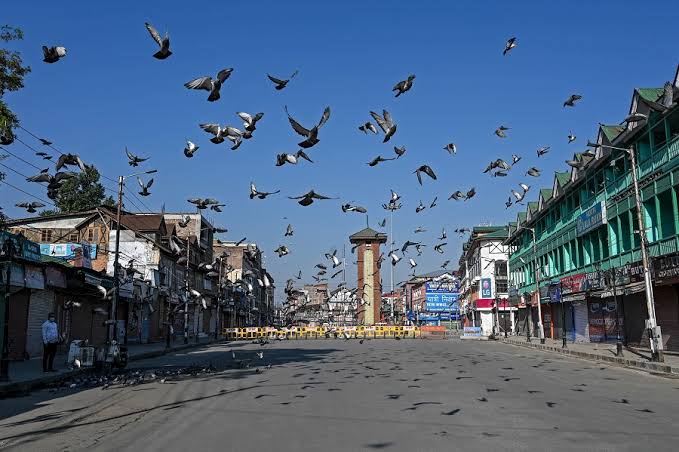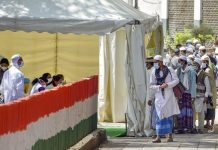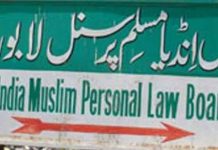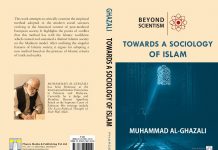After one year now Revival of Kashmiriyat is the need of hour
India is on the verge of first anniversary of abrogation of Article 370 and Article 35 A in Kashmir. It was 5th August, 2019 when all of sudden,Kashmiris lost their identity. Curfew was imposed in most part of land. Media was not allowed for news coverage, political leaders were arrested. Even after almost one year, Kashmir is under lockdown by various reasons. In this secenario, have a look at past of this Paradise. Big question of the day that when will we see Kashmiriyat in the valley?
Zainab Ashraf siyasat.net
New Delhi The first anniversary of abrogation of Article 370 is on 5th August and to celebrate it on a large scale, the ruling regime choose the same date to keep the formation stone(Bhoomi Pujan) of Ram Mandir. At the time of independence, the Congress party brought this article as a bridge between India and Kashmir with the intention of slowly and steadily destroying it. But the NDA government headed by Narendra Modi did this in just a single stroke.
While the mainstream media and history books have always treated Kashmir as some sort of pawn in a chess game between India and Pakistan. Therefore, it becomes important to demystify the history of Kashmir and the Kashmiris to get a sense of political happening that led to the making of what is today one of the most militarized zone in the world.
The story of its annexation begins at the end of Chak dynasty. The last ruler of this dynasty was Yakub Shah and in 1586, he was defeated by the army of Akbar, led by Qasim Khan. The Mughals had played a pivotal role in boosting the tourism of Kashmir. First, Akbar took over Baltistan and Ladakh and then he built the Imperial road, also known as the Mughal road which connects Lahore to Kashmir. His son, Jahangir, contributed by building major historical monuments like Shalimar Bagh and Achabal and his brother-in-law, Asif Khan built Nishat Bagh. The son of Jahangir, Shahjahan further constructed Chashme Shahi and Pari mahal. His son, Aurangzeb, constructed Safa Kadel and he made Kashmiri shawls the major export item. After the death of Aurangzeb, Afghan ruler, Ahmed Shah Abdali took over Delhi in 1753 and so Kashmir also slips from the hands of Mughals into the hands of Afghans but his rule lasts only for five months. Soon the next Mughal ruler, Alamgir II dethrone Abdali and he made Sukh Jiwan Mal as the governor of Kashmir. So, the Mughals reign back over Kashmir from 1753 to 62.

In 1762, Abdali again conquered Kashmir and this time, Aghans rule for continuously 57 years over Kashmir from 1762 to 1819. In comparison to the Mughals, the Afghans didn’t contribute anything in Kashmir rather they worsen its economy, use Kashmiris as slaves in Afghanistan and the export of shawl was majorly hit during their reign. The last Afghan ruler was Ayub Shah and finally, at the Battle of Shopian, Kashmir went into the hands of Sikh ruler, Ranjit Singh in 1819 and he made Gulab Singh, a Dogra, the Maharaja of Jammu in 1822. The last ruler from Sikh empire was Duleep Singh and during his reign, the first Anglo-Sikh War (1845-46) occur. The war was ended by signing the Treaty of Lahore between Duleep Singh and Sir Henry Hardinge. In this Treaty, the Lahore Darbur was required to pay an indemnity of rupees one crore but it was not in this position to pay such a huge amount and so Gulab Singh who was actually on the side of the Britishers, purchased Jammu & Kashmir and Ladakh for 75 Lakhs under the Treaty of Amritsar signed on 16th March 1846. From here, the Dogra reign begins and it lasts till 1947.
With each new conqueror, the intensity of cruelty was increasing, the Sikhs were treating Kashmiris a little better than cattle and the Dogras also started to exploit Kashmiris by imposing heavy taxes on them, grabbing about 50-75% of peasants property, the Muslim Kashmiris even had to pay tax for getting married in an attempt to raise 75 Lakhs that Dogra had paid to buy Kashmir. Moreover, under the Dogra rule, the Kashmiris were forced to fight for the Britishers in the two World Wars. In addition to all this, there was a discrimination between Kashmiri Muslims and Hindus,muslim populace was institionally and systematically discrimination and their socio economic position during the dogra rule was horrible.Most of the high positions were held by Pandits. The Dogras also replaced Koshur by Urdu which further hit the Koshur speaking Muslims population. In 1931, the Dogras, approved the formation of three political parties-Kashmiri Pandits Conference, Hindu Sabha in Jammu and Sikh’s Shiromani Khalsa Darbar. This left the majority of the population without an official political party. The situation of Kashmir was getting worse under the partition plan. There were in total 565 princely states at the time of independence and they had the authority to either join India or Pakistan or to live Independently.

The Maharaja of Kashmir signed standstill agreement with both India and Pakistan and Kashmir remained an independent entity for some time, after strong resentment and resistance put by a majority Muslim populace supported by tribesmen from Pakistan Mahraja was made to sign instrument of accession with India what is believed to have been signed under duress and without any consultation from an already aggravated population. What really makes instrument of accession a controversial event is unrepresentative character of an unelected Maharaja ruling under the sovereignty of British, the complete denial of political participation and decision making to a whole population. Well, as per that agreement, Hari Sigh official joined India and the PM of India sent troops to protect the borders to make Kashmir part of India by force. In addition to this, article 370 was guaranteed which gives special status to Jammu and Kashmir. Under this article, Kashmir can have its own flag, constitution and independence over all matters except foreign affairs, defense and communications. This article used to work in correlation to article 35-A which aims to protect the demography of the state by restricting the foreigners buying land and property over there.
The UN resolutions passed in 1948 demanded India and Pakistan leave it to people of Jammu and Kashmir to decide their fate through plebiscite or right to self-determination. The resolution 47,stipulated that both India and Pakistan should withdraw their military forces and arrange for a plebiscite to be held in order to provide the people of Kashmir the choice of which state to join. Earlier, Nehru was in favour to hold a plebiscite to determine the faith of Jammu and Kashmir but this golden opportunity was never given to the people of Kashmir. But eventually, it became clear that Nehru had no intention of giving liberty to Kashmiris to let them decide with whom they want to go. Since then, the Kashmiris are fighting for their right to self-determination.
At the time of partition, in all the three sections-Jammu, Kashmir and Ladakh, the Muslims were in the majority but in 1947 many Muslims of Jammu were massacred and others drive away to West Punjab. Those killings were carried out by extremist Hindus and Sikhs, aided by the forces of Maharaja Hari Singh. Now, the Muslims are in the minority in Jammu.
Feared to meet the same fate, the Muslims of Kashmir started revolting against India and that revolt reaches the peak in 1989 in the form of militancy. To curb it, the central government on 19 January 1990 impose direct rule on the state. From the outset, the Indian government’s campaign against the militants was marked by widespread human rights violations, including the shooting of unarmed demonstrators, civilian massacres, and summary executions of detainees.
Indian forced launched a massive cordon and search operations, killing militants, and allegedly detaining civilians, execution of men and children and worst of all rapes. With an increase in repression from Indian side many folds, the resistance from people grew equally.
In the mid-1990s, Indian security forces began arming and training local auxiliary forces made up of surrendered or captured militants to assist in counterinsurgency operations. These state-sponsored paramilitary groups have committed serious human rights abuses, and human rights defenders and journalists have been among the principal victims. The major Act that governs military action in Jammu & Kashmir is the Armed Forces (Special Powers) Act, 1958 [as amended in 1972].
The act has immunised Indian forces from any punishment for violating human rights.
Since then there were popular civilian uprisings which were triggered by various events like Amarnath Land row in 2010 in which more than 100 civilians were killed and many injured. The killing of a school kid Wamiq Farooq in 2010 led to another summer of unrest in which more than 100 civilians died at the hands of security forces, which was followed by another bloody summer after the controversial hanging of Afzal Guru.
From 2010 onwards, the Kashmiri saw a rise of new-age militancy. Educated youth from colleges and universities joined militant ranks. A young boy from Tral known as a Burhan Wani became the face of this new phase of militancy. Very few in number and very low on artillery but they gained huge support from the civilian population of Kashmir. In 2018, Burhan Wani was killed by security forces in an operation at Anantnag village. This was followed by huge protests and demonstrations from around the valley. The government imposed a curfew, stopped internet and mobile services for months together.
More than 100 civilians were killed, hundreds blinded by pellets and thousands were injured by security forces the who defied curfew and went out protesting.
Kashmir had hardly come out of this spiral of violence and special status guaranteed by article 370 and 35-A (stripping J & K of its autonomy) of the Indian constitution was scrapped by the NDA government last year.
The Indian government imposed ruthless curfew lockdown, controling media, gagging mobile Internet and broadband services. The 4G mobile Internet services are barred in Kashmir till date. Above all this, with domicile rights made flexible and revocation of 35-A, most Kashmiris believe the influx of thousands non-Kashmiris every year is aimed at changing the demographics of their native land and eventually turn a majority into a minority in the long run. (Views are personal)
(Author is studying a Masters in Development Communication at Jamia Millia Islamia, Delhi)
(www.siyasat.net is Ahmedabad,Gujarat, India based website)
































